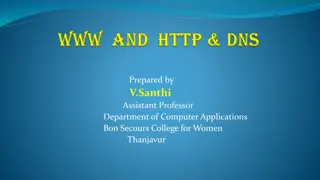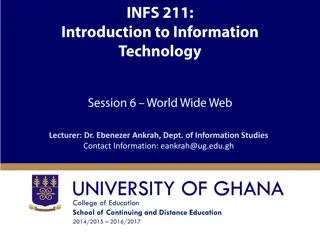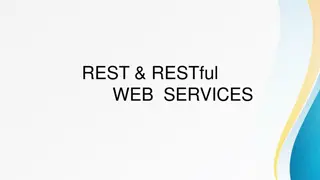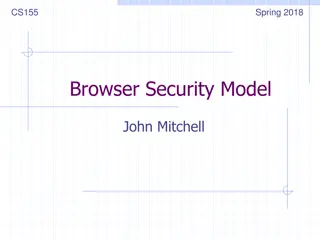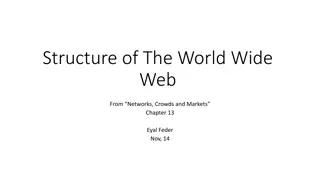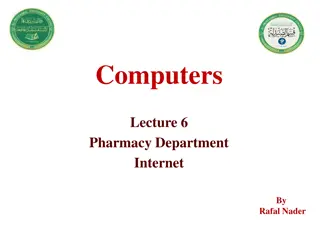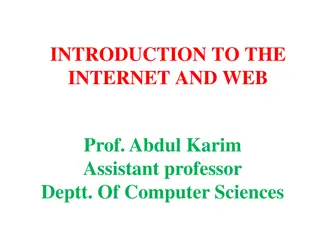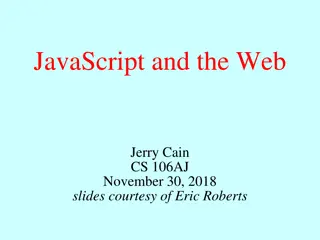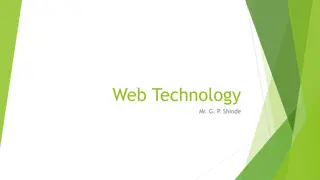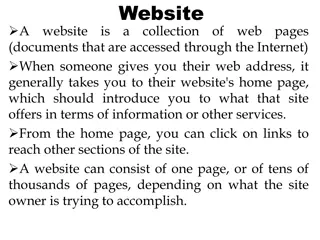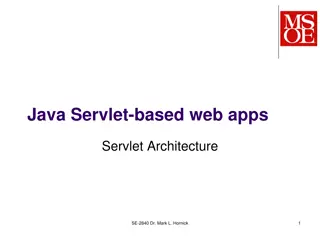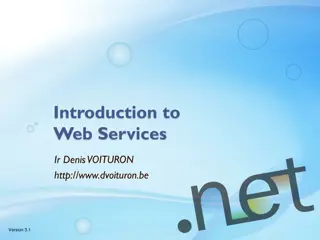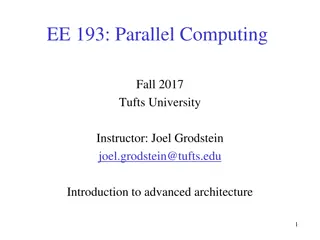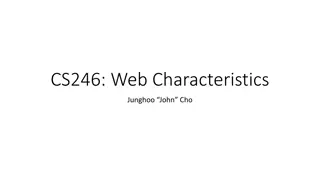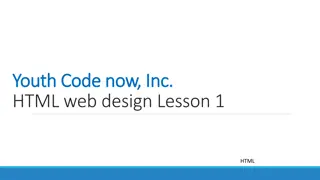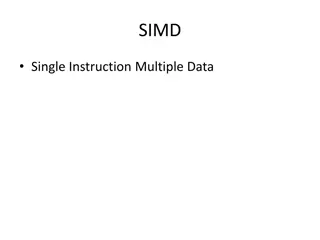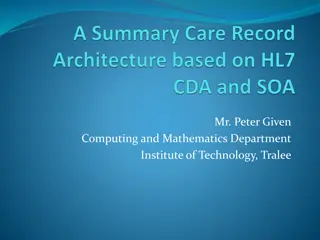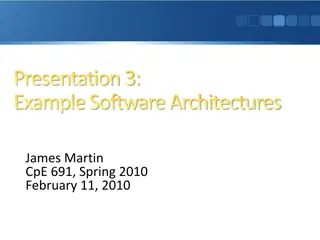Understanding the Architecture of the World Wide Web
The World Wide Web is a distributed information system that provides access to hypertext documents and various resources. Resources can include electronic documents, images, services, and more. The key concept in the Web architecture is the notion of resources, which need to be identified, represented, and interacted with. Uniform Resource Identifiers (URIs) play a significant role in identifying resources in the Web infrastructure.
Download Presentation

Please find below an Image/Link to download the presentation.
The content on the website is provided AS IS for your information and personal use only. It may not be sold, licensed, or shared on other websites without obtaining consent from the author. Download presentation by click this link. If you encounter any issues during the download, it is possible that the publisher has removed the file from their server.
E N D
Presentation Transcript
The Architecture of the World Wide Web COMP3220 Web Infrastructure COMP6218 Web Architecture Dr Nicholas Gibbins nmg@ecs.soton.ac.uk
What is the Web? The Web is a distributed information system that provides access to hypertext documents and other objects of interest We have a general name for these objects of interest: resources 3 3
What is a resource? Familiar examples [of resources] include an electronic document, an image, a source of information with a consistent purpose (e.g., today's weather report for Los Angeles ), a service (e.g., an HTTP-to-SMS gateway), and a collection of other resources. A resource is not necessarily accessible via the Internet; e.g., human beings, corporations, and bound books in a library can also be resources. Likewise, abstract concepts can be resources, such as the operators and operands of a mathematical equation, the types of a relationship (e.g., parent or employee ), or numeric values (e.g., zero, one, and infinity). Berners-Lee, T. et al (2005) Uniform Resource Identifier (URI): Generic Syntax. RFC3986. 4 4
Example Resource today s BBC weather forecast for Southampton 5 5
Architectural Bases of the Web The notion of a resource is central to the architecture of the Web We need to be able to: identify them represent them interact with them 6 6
Uniform Resource Identifiers A compact string of characters for identifying an abstract or physical resource Example: http://www.ecs.soton.ac.uk/ General syntax: <scheme>:<hierarchical part>?<query>#<fragment> 8 8
Example URI http://www.bbc.co.uk/weather/2637487 Resource today s BBC weather forecast for Southampton 9 9
URI Schemes and Examples http://www.example.org/aboutus#staff https://www.example.org/login mailto:joe@example.org ftp://example.org/aDirectory/aFile news:comp.infosystems.www tel:+1-816-555-1212 ldap://ldap.example.org/c=GB?objectClass?one urn:oasis:names:tc:entity:xmlns:xml:catalog 10 10
Identification Principles 1. Identifiers should be global Global naming leads to global network effects. We want to avoid creating walled gardens. 11
Every object should be addressable In principle, every object that someone might validly want/need to cite should have an unambiguous address (capable of being portrayed in a manner as to be human readable and interpretable). (e.g., not acceptable to be unable to link to an object within a frame or card. ) Englebart, D.C. (1990) Knowledge-Domain Interoperability and an Open Hyperdocument System. Proceedings of the Conference on Computer-Supported Collaborative Work. 12 12
Identification Principles 1. Identifiers should be global Using the same URI to directly identify different resources produces a URI collision. 2. Assign distinct identifiers to distinct resources Example: using http://www.ecs.soton.ac.uk/ to refer to both a university department and a web page about that department Collision often imposes a cost in communication due to the effort required to resolve ambiguities. 13
Identification Principles 1. Identifiers should be global A URI owner SHOULD NOT associate arbitrarily different URIs with the same resource. 2. Assign distinct identifiers to distinct resources 3. Avoid aliases Example: http://www.soton.ac.uk/ and http://www.southampton.ac.uk/ both refer to the same resource but we can t tell that just by looking at the identifiers (URIs are opaque) The value of a given resource can be measured by the number and value of the resources that link to it 14
The Early Web Early (pre-1991) documents refer to document naming As many protocols are currently used for information retrieval, the address must be capable of encompassing many protocols, access methods or, indeed, naming schemes A hypertext link to a document ought to be specified using the most logical name as opposed to a physical address. This is (almost) the only way of getting over the problem of documents being physically moved. As the naming scheme becomes more abstract, resolving the name becomes less of a simple look-up and more of a search. http://www.w3.org/DesignIssues/Naming 15 15
The Classical View Uniform Resource Identifiers Uniform Resource Names Independent of location or protocol (e.g. isbn) Uniform Resource Locators Explicitly associated with network protocols (e.g. http, ftp, etc) 16 16
The Classical View URL resolution is (usually) well-defined URNs don t necessarily have well-defined resolution semantics Resolving names depends on context What does resolution mean for URIs which do not refer to network resources? 17 17
The Modern View Formal URL/URN distinction is unhelpful, but... URL is a useful informal concept a URL is a type of URI that identifies a resource via a representation of its primary access mechanism http://www.w3.org/TR/uri-clarification/ 18 18
Defining Representation A representation is data that encodes information about resource state. Representations do not necessarily describe the resource, or portray a likeness of the resource, or represent the resource in other senses of the word "represent". Representations of a resource may be sent or received using interaction protocols. 20 20
Example Resource today s BBC weather forecast for Southampton Representation Metadata: Content-Type: text/html Data: <html> <head> <title>BBC Weather Southampton</title> ... </html> 21 21
Representation Example Metadata: Content-Type: video/mp4 Data: Resource today s BBC weather forecast for Southampton Representation Metadata: Content-Type: text/html Data: <html> <head> <title>BBC Weather Southampton</title> ... </html> 22 22
Internet Media Types Hierarchical descriptions of data types (used originally in email - MIME) Top-level types: text, image, audio, video, application (also multipart and message) Refinements of these top-level types: text/plain, text/html, text/xml, text/csv, image/jpeg, image/gif, image/png, image/tiff, audio/mpeg, audio/ogg, video/mp4, video/quicktime, application/ecmascript, application/pdf, application/rdf+xml, 23 23
Representation Principles 1. Separate content, presentation and interaction A representation format should allow authors to separate content from both presentation and interaction concerns. How a resource is presented to a user (e.g. mobile versus desktop), and how the user interacts with that resource, are independent of the informational content of the resource. 24
Content, Behaviour, Presentation ECMAScript DOM HTML CSS XML XSLT Behaviour SVG Data Content Visual Style PNG MathML Web Resource 25 25
Representation Principles 1. Separate content, presentation and interaction A representation format should provide ways to identify links to other resources, including to secondary resources (via fragment identifiers). 2. Identify links 26
Representation Principles 1. Separate content, presentation and interaction A representation format should allow Web-wide linking, not just internal document linking. 2. Identify links 3. Links should be web-wide (a corollary of global identifiers) 27
Representation Principles 1. Separate content, presentation and interaction A representation format should allow content authors to use URIs without constraining them to a limited set of URI schemes. 2. Identify links 3. Links should be web-wide 4. Links should use generic identifiers Formats should be future-proof; we don t know what identifier types or protocols we ll be using in the future. 28
Representation Principles 1. Separate content, presentation and interaction A representation format should incorporate hypertext links if hypertext is the expected user interface paradigm. 2. Identify links 3. Links should be web-wide We would like links between resources to be able to behave like any other hypertext links. 4. Links should use generic identifiers 5. Links should be navigable 29
Interaction The interactions between Web agents and resources are defined in terms of protocols that control the exchange of messages HTTP, FTP, SOAP, NNTP, SMTP, ... Messages include both data and metadata Data: the informational content of the message Metadata: a description of the message and its content 31 31
Dereferencing URIs The schemes in URIs used to identify resources may indicate protocols that can be used to access those resources Though not always: caches, proxies, name resolution services (DNS) Many URI schemes define a default interaction protocol Resource access takes several forms: Retrieving a representation of the resource Adding or modifying a representation of the resource Deleting some or all representations of the resource 32 32
Example URI http://www.bbc.co.uk/weather/2637487 Resource yields on dereference today s BBC weather forecast for Southampton Representation Metadata: Content-Type: text/html Data: <html> <head> <title>BBC Weather Southampton</title> ... </html> 33 33
Interaction Principles 1. Reuse representation formats New protocols created for the Web should transmit representations as octet streams typed by Internet media types. 34
Interaction Principles 1. Reuse representation formats A URI owner should provide representations of the resource it identifies. 2. Provide representations There is a general expectation that it should be possible to retrieve a representation of any resource. 35
Interaction Principles 1. Reuse representation formats Agents do not incur obligations by retrieving a representation. 2. Provide representations 3. Retrieval should be safe Put another way, the act of retrieving a representation of a resource should not have any significant side-effects (for example, deleting the resource or changing its state). 36
Interaction Principles 1. Reuse representation formats An application developer or specification author should not require networked retrieval of representations each time they are referenced. 2. Provide representations 3. Retrieval should be safe 4. Reference does not imply dereference Just because you can retrieve a representation of a resource, doesn t mean that you must. Example: URIs used to identify document schemas: http://www.w3.org/TR/html4/strict.dtd 37
Interaction Principles 1. Reuse representation formats A URI owner should provide representations of the identified resource consistently and predictably. 2. Provide representations 3. Retrieval should be safe 4. Reference does not imply dereference We want our identifiers to be persistent: once an identifier has been associated with that resource, it should continue to refer to that resource indefinitely. 5. Representations should be consistent (a matter of policy, not technology) 38
Conclusion URI http://www.bbc.co.uk/weather/2637487 Resource yields on dereference today s BBC weather forecast for Southampton Representation Metadata: Content-Type: text/html Data: <html> <head> <title>BBC Weather Southampton</title> ... </html> 39 39
Summary The Web Architecture has three parts: Identification (URIs) Representation (formats: HTML, XML, PNG, etc) Interaction (protocols: HTTP) 40 40
Further Reading Architecture of the World Wide Web, Volume One http://www.w3.org/TR/webarch/ Architectural Styles and the Design of Network-based Software Architectures, Chapter 4 http://www.ics.uci.edu/~fielding/pubs/dissertation/top.htm 41 41






